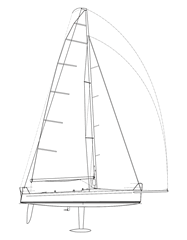Farr 36
Racerr
I didn't expect to get hull lines from the Farr office. That would make it too easy to copy the hull shape, and I understand completely: Hull shapes should be proprietary. It's difficult to make definitive statements based on the profile and plan views alone. But I'm going to take a stab at it anyway.
To my eye the hull shape looks "normal" in plan, although in profile the rocker appears deep forward and flattened amidships. The deepest part of the canoe body is right under the mast, and overhangs are absolutely minimal. This boat is not narrow and weighs only 6,695 pounds for a D/L of 84.69 and an L/B of 3.15. I think that the beam must be there for stability. With a lead bulb on a carbon fin and 8 feet, 6 inches of draft the righting moment at one degree is 810 foot-pounds. As I recall-and it's been a while-that's about the same RM that you would find on a 36-foot One-Tonner circa 1978. Of course, the One-Tonner weighed about twice as much as does this new 36-footer.
Note the shape and location of the keel-fin and its area relative to that of the rudder. This rudder is about 82 percent of the actual keel-fin area. The fin is well aft and that reflects the size of the mainsail and the keel's role in balancing the rig. It also puts the weight of the ballast much closer to the overall longitudinal center of gravity of the boat, which reduces pitching. I see no indication of a kelp cutter on the drawings. The keel mounts in a sleeve that goes to the bottom of the cockpit sole.
The promotional material talks briefly about the interior. I call this interior "Camp X-ray." It's not laid out for crew. It's laid out for detainees. There are four berths per side to keep the crew weight outboard. There is a head, sink and two-burner stove forward. I'm not sure why there is a layout. You couldn't sleep your crew below at regattas. The condensation from their breath while sleeping would require daily drying out since the extra weight would make you uncompetitive. I think on a long race dinner would be protein bars with Juicy Fruit gum for desert. I once experimented with dried German sausages stowed in my sea bag, but I smelled like a delicatessen for a month.
The rig is all carbon fiber. Heck, this entire boat is carbon fiber. The rig is big. Using I, J, E and P, I get a sail area of 773 square feet. If you add the roach of the main to that you get a total sail area of 877 square feet. Let's use the big number, which gives us an SA/D of 39.5. That should turn your cap backwards. I'm sitting here trying to imagine the acceleration out of a tack with that much horsepower. The masthead asymmetrical chute will add another 1,319 square feet. Or, if you are not feeling brave, you can go with the fractional chute. Either way, off-the-wind horsepower is no problem. There are no runners. Spreaders are swept 24 degrees, and there is a standing backstay with a wand to help the roach clear the backstay in tacks.
Boats like this are all detail and have to be built with no shortcuts. Barry Carroll's Carroll Marine work crew has become the industry leader in building these kinds of yachts. Carroll Marine turns out gems. Given the strict one-design nature of this boat, quality control will be very tight to insure competitive tolerances. A boat like this could even rekindle my own interest in racing. I had better get in line now.
The latest red-hot one-design from the Farr office

Comments